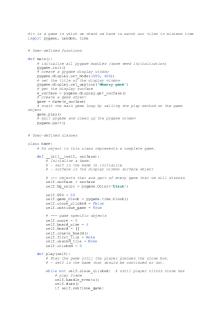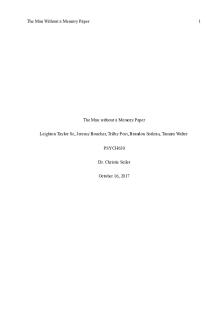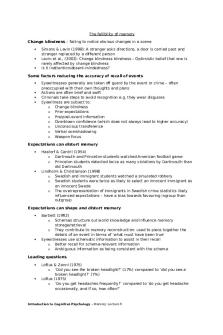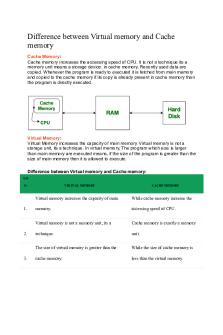Flashbulb Memory - Grade: A PDF

| Title | Flashbulb Memory - Grade: A |
|---|---|
| Course | Introduction To Psychology |
| Institution | Pace University |
| Pages | 2 |
| File Size | 64.8 KB |
| File Type | |
| Total Downloads | 23 |
| Total Views | 128 |
Summary
Essay...
Description
Evaluate one theory of how emotion may affect one cognitive process. Memory and the Flashbulb theory will be evaluated in this paper. The cognitive level of analysis aims to study the inner processes of the mind and how cognitive processes guide behaviour. Emotion may affect the cognitive process of memory by way of Flashbulb Memory (FBM) suggested by Brown & Kulik (1977). Flashbulb Memories are a emotional memories that have vivid and detailed (photographic-like) recall due to the highly emotional event “recorded” in the brain (as though a ‘camera’s flash). FBM can be triggered by a happy or traumatic event. The event can be personal or something that captivated the world. FBM can be used to explain how emotion can affect/influence memory by either enhancing it or impairing it. I will be discussing studies by Brown and Kulik (1977) and Neisser and Harsch (1992). Brown and Kulik (1977) aimed to investigate FBM and how it works. They interviewed 80 Americans (40 African Americans and 40 Caucasian Americans). They answered questions about 10 events, 9 of them mostly on assassinations or attempted assassinations of well-known American personalities and the last event being self-selected. The participants were asked how often they rehearsed the events being recalled, whether overt or covert rehearsal. Overt is through discussing with other people and covert is private rehearsing. They found that J.F. Kennedy's assassination in 1963 had the most flashbulb memories of all participants. 90% of participants recalled this event in context and with vivid detail. African Americans recalled more FBM's of civil right leaders than the Caucasians which could be in part to culture/schema. The self-selected event were commonly of shocking life events like the death of a parent. This study supported the theories of flashbulb memories. Some of those being that they are: formed in encounters that are surprising and highly emotional, kept fresh by means of overt and covert rehearsal, and are more vivid than other memories. A strength of this study is that it has high
ecological validity. A criticism is that the events the participants were tested on were specific to America and cannot be used to make a sweeping generalization about the whole world. There could have researcher bias and the ethical considerations of the participants might having been distressed to the recollection of these events could have occurred. An arguing study is Neisser and Harsch (1992) which called into question the validity and accuracy of FBM is by Neisser (1982), and later on by Neisser and Harsch (1992). Neisser suggested that the memories are vivid only because the event is rehearsed and reconsidered after the event and argued that they are subject to the same types of inaccuracy and forgetting as any other memories. The participants were asked to report how they learned about the challenger space disaster on 1986. They tested the accuracy of the incident 24 hours after the accident and then again two years later. 1 day after the disaster, 215 of the participants reported that they heard about the disaster on television, but 2 and a half years later, 45% said they heard it on T.V. How they supposedly learned about the event changed. The memories of how they had heard about the event had deteriorated after time. This information suggests that FBM are not reliable (as influenced by post-event information). Neisser and Harsch claimed that the findings suggest that FBM's may just be ordinary memories Flashbulb Memories are affected by emotion and can influence the recall of memories. However, it is hard to test because the evidence is retrospective. Some overall strengths are that it was ecologically valid and involved people’s real reactions and memories. An overall weaknesses was that the studies couldn’t be replicated. Therefore the results could not be tested for reliability with another rest....
Similar Free PDFs

Flashbulb Memory - Grade: A
- 2 Pages

Faulty Memory - Grade: A
- 5 Pages

False Memory Lab - Grade: A
- 7 Pages

Memory essay - Grade: 1st
- 5 Pages

Memory
- 3 Pages

Memory
- 5 Pages

A child - Grade: A
- 5 Pages

The Man Without A Memory Paper
- 5 Pages

Virtual Memory
- 58 Pages

CACHE MEMORY
- 1 Pages

Memory Psych
- 1 Pages

Virtual Memory
- 17 Pages

Memory notespack
- 16 Pages
Popular Institutions
- Tinajero National High School - Annex
- Politeknik Caltex Riau
- Yokohama City University
- SGT University
- University of Al-Qadisiyah
- Divine Word College of Vigan
- Techniek College Rotterdam
- Universidade de Santiago
- Universiti Teknologi MARA Cawangan Johor Kampus Pasir Gudang
- Poltekkes Kemenkes Yogyakarta
- Baguio City National High School
- Colegio san marcos
- preparatoria uno
- Centro de Bachillerato Tecnológico Industrial y de Servicios No. 107
- Dalian Maritime University
- Quang Trung Secondary School
- Colegio Tecnológico en Informática
- Corporación Regional de Educación Superior
- Grupo CEDVA
- Dar Al Uloom University
- Centro de Estudios Preuniversitarios de la Universidad Nacional de Ingeniería
- 上智大学
- Aakash International School, Nuna Majara
- San Felipe Neri Catholic School
- Kang Chiao International School - New Taipei City
- Misamis Occidental National High School
- Institución Educativa Escuela Normal Juan Ladrilleros
- Kolehiyo ng Pantukan
- Batanes State College
- Instituto Continental
- Sekolah Menengah Kejuruan Kesehatan Kaltara (Tarakan)
- Colegio de La Inmaculada Concepcion - Cebu


